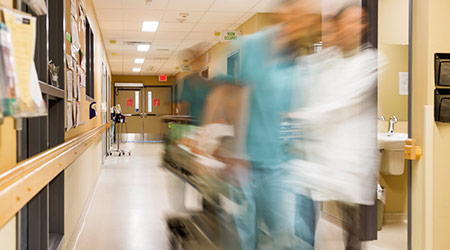What keeps you up at night?
It’s an unsettling question, but it’s also one that is asked at the beginning of an organization’s crisis communication planning process. As the leader of a healthcare facility, your answer might include a disgruntled former employee, an irate family member, an altercation, a shooting, a fire, a tornado or a structural failure. As you know, these crises can stop your operations in the blink of an eye.
Asking health care facility leaders what keeps them up at night is a sound start to develop a robust crisis communication plan - put in place to support the operational crisis plan. While your health care system may have a sound operational plan in place, is there a sound communication plan in place? One that is comprehensive in nature, given today’s multiple communication channels such as social media and the 24/7 news cycle? A lot has changed in the past few years, and your communication responses need to keep up.
Imagine one of the worst-case scenarios taking place at your health care facility and then play out the scenario further. For example, what if during the crisis the power is off and the channels and technologies you thought were in place, to get through to staff and patients, aren’t functioning. What’s your backup plan? And, then, what’s your backup to the backup plan to ensure communication is still being deployed to staff, patients, families, etc.?
These questions and more should be discussed now, ahead of any potential crisis, to ensure multiple scenarios are laid out and agreed-upon plans are in place. It is imperative that the messages you send during a crisis are vetted by your team. The planning process should be comprehensive and include many questions that begin with, “What if?” It’s not uncommon that the conversations that take place during the process will uncover communication deficiencies, weaknesses within your organization or employee red flags. This gives you the opportunity to address these issues now and resolve them before a crisis occurs.
Developing a robust crisis communication plan does take time and resources upfront but will help improve your communication process before a crisis happens. The dialogue that takes place during the planning process is where a lot of vital learning takes place. Through the planning process, when talking through specific scenarios and the people and tools available to you, it will become apparent where the vulnerabilities are and from there you can proceed to identify alternatives, correct those you currently have and test your communication channels.
The planning process team should include multiple disciplines including facilities management, legal, human resources and patient-facing representatives to ensure that no stone is left unturned. Each offers a different trigger point for communication which can be valuable during a significant event. For example, if a staff member is hurt onsite during an incident, who is responsible for notifying family members? Is that contact information readily available? Will the authorities be responsible for this task? Is information accessible by more than one person? Who is confirming the details and accuracy of the report?
Areas to include in the crisis communication plan are: audiences you may need to reach, current technology platforms (i.e., texting software, pagers), traditional channels of communication (i.e., landline phone, email), identification of the internal response team, worst-case scenarios, pre-written communication depending on the situation and inclusive contact information for any and all who could potentially be involved (executive team members, facilities managers, local emergency contacts and more).
Another very important piece to the crisis communication plan is to make sure you have a streamlined process in place, to ensure communication cascades from the time an incident occurs to post-incident? For example, if a shooter is on campus and the hospital is on lock down (assuming 911 has been called), how is this information communicated internally for safety purposes? How about externally to the public at large? As we have seen time and time again, social media is a channel that can be used for both internal and external purposes – will your organization depend on these channels to push out messaging? Do you have a streamlined process in place to use it? Do the right people have access to those channels and do they know how to use them?
Once a crisis event has passed, how does your organization’s communication look then? Again, remember, from a communication perspective there are multiple channels that may need to be addressed. An example of cross over between online and traditional communication channels could be your organization having a press conference with members of the media while broadcasting live on Facebook.
Remember two things as you embark on creating a robust crisis communication plan: The first is the crisis communication plan is never finished and requires constant updates as people, process and technologies change. The second is that the plan is only as good as how you reference it and practice it. The point is not to create a crisis communication plan to sit on the shelf. Create awareness of the plan as well as instigate and participate in communication training opportunities.
Whatever shape your crisis communication plan is in, this is your opportunity to walk and talk through it with your team. The more practice that takes place, the more process improvement will occur.
Lisa Cruz is the president of Red Shoes Inc., a full-service strategic communication firm that specializes in crisis communication.

 All Eyes on Gen Z as They Enter the Workforce
All Eyes on Gen Z as They Enter the Workforce Cleveland Clinic Starts Fundraising Effort for New Hospital in West Palm Beach
Cleveland Clinic Starts Fundraising Effort for New Hospital in West Palm Beach Cultivating a Workforce in the Face of Skilled Trade Shortages
Cultivating a Workforce in the Face of Skilled Trade Shortages Prime Healthcare Acquires 8 Ascension Hospitals in Illinois
Prime Healthcare Acquires 8 Ascension Hospitals in Illinois Charging Ahead: Incentives Driving EV Charging in Healthcare Facilities
Charging Ahead: Incentives Driving EV Charging in Healthcare Facilities